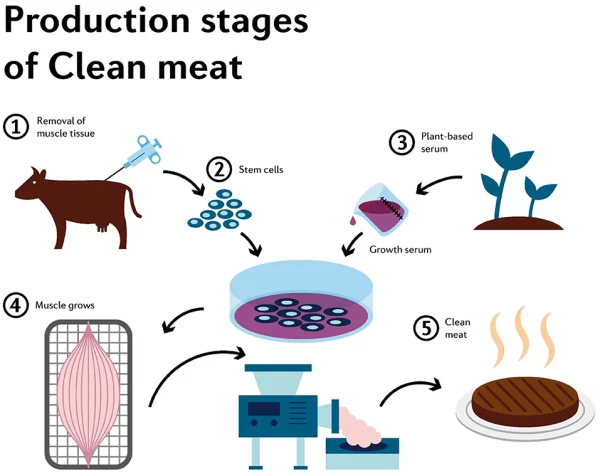In recent years, cultured meat technology has become a controversial topic, drawing significant attention from scientists, food companies, and consumers alike. This technology allows for the production of meat without the need for traditional livestock farming, opening up the possibility of creating sustainable food and minimizing environmental impact. However, whether cultured meat is truly the future of the food industry remains a question that requires further research.
Cultured meat not only addresses ethical concerns regarding the slaughter of animals but also offers numerous environmental benefits. Recent studies show that producing meat from animal cells in a controlled environment helps reduce negative impacts on the Earth. According to the Food and Agriculture Organization (FAO), traditional livestock farming, particularly cattle, contributes approximately 14.5% of global greenhouse gas emissions. This is a significant number, especially when compared to the potential benefits that cultured meat can offer. “Producing meat from cells instead of animal bodies not only saves resources but also helps reduce greenhouse gas emissions,” said Dr. Emily White, researcher at the Center for Innovative Food Technology (Food Science Review, 2023).

In addition to its environmental impact, cultured meat is also expected to address the growing food scarcity issue in the face of a rising global population. Currently, the supply of animal-derived meat cannot meet the increasing demand from consumers. According to the U.S. Institute of Food and Agriculture Research (2022), the livestock industry requires vast resources, including land and water, to produce a certain amount of meat. Cultured meat, on the other hand, can use resources more efficiently while reducing waste. “Cultured meat can provide the necessary protein without harming nature, making it an excellent solution to future food shortages,” shared John Green, CEO of New Innovative Food Company (Innovation in Food, 2023).
What is noteworthy is that the production of cultured meat is not just a theoretical research topic; actual products have already been introduced to the public. In 2013, Maastricht University unveiled the first cultured beef burger. Although this burger had a high price tag of 250,000 USD, it passed the taste and quality tests. While production costs are still high, according to a Harvard University Report, with advancements in technology and large-scale production, the cost of cultured meat is expected to decrease significantly in the coming years. “We can expect that in the near future, cultured meat will become a mainstream product at an affordable price,” Dr. Lisa Martin, a food biotechnology expert at the International Center for Biology and Food (Global Food Technology Journal, 2024).
“Cultured meat is a major breakthrough that could change the entire food industry, from supply sources to production processes, and may very well become an inevitable trend in the near future,” said Dr. Thomas Harris, scientist at the Institute of Biological and Food Technology Research (International Food and Technology Review, 2024).
In summary, cultured meat is not only a high-tech food product but could also be an important solution to global environmental, ethical, and food scarcity issues. With rapid advancements in cell culture technology, it can be said that in the next few decades, cultured meat will no longer be a distant concept but will become an essential part of our meals.


HPX24h > Science > Why Cultured Meat Could Be the Future of the Food Industry
Top Reads from This Category
Science
The Secret of the Bee Brain: New Technology Enables Drones to Fly Independently
Science
The Shocking Truth About Medical Bandages: Harmful Chemicals Absorbed Through Wounds
Science
Stem Cells and Gut Cultures: Unlocking New Possibilities for Treating Digestive Disorders
Science
Nanotech Technology to Destroy Blood Clots: A New Breakthrough in Stroke and Heart Attack Treatment
Science
Discovery of a New Stem Cell: A Major Advancement in Creating Human Organs
Science
Recreating the Mouse Brain in a Virtual World: The Future of Neuroscience
Science
Science Uncovers the Brain’s Process of Storing New Ideas
Discover New Topics
Science
New Hope for the Blind: A Breakthrough in Retinal Implant Technology
Animals
Baboons With Stable Relationships Live Longer and Show Greater Kindness
Healthy Eating
Understanding the Important Role of Carbohydrates in Health
Health
E. Coli In The Gut May Trigger A ‘Chain Reaction’ Leading To Parkinson’s Disease
Animals
Stickleback Fish’s Secret to Adapting from Saltwater to Freshwater: How Genetic Mutations Enable Remarkable Adaptation
Science
Regrowing Adult Teeth in Just 9 Weeks: Science Turns the Impossible into Reality
Animals
Decoding Whale Songs: When the Community Joins to Uncover the Ocean’s Mysteries
Science
Why Do Adult Brains Continue to Generate New Neurons?
Health
The Best Days to Get Pregnant: How to Accurately Time Your Ovulation?
Parenting Tips
Why Your Child Might Be Coughing Disruptively During Sleep?
Health
Natural Remedies for Stomach Pain Every Parent Should Know
Parenting Tips
How to Talk to Your Child About Drugs Effectively
Fitness
Active Recovery: The Key to Reducing Soreness and Boosting Workout Performance